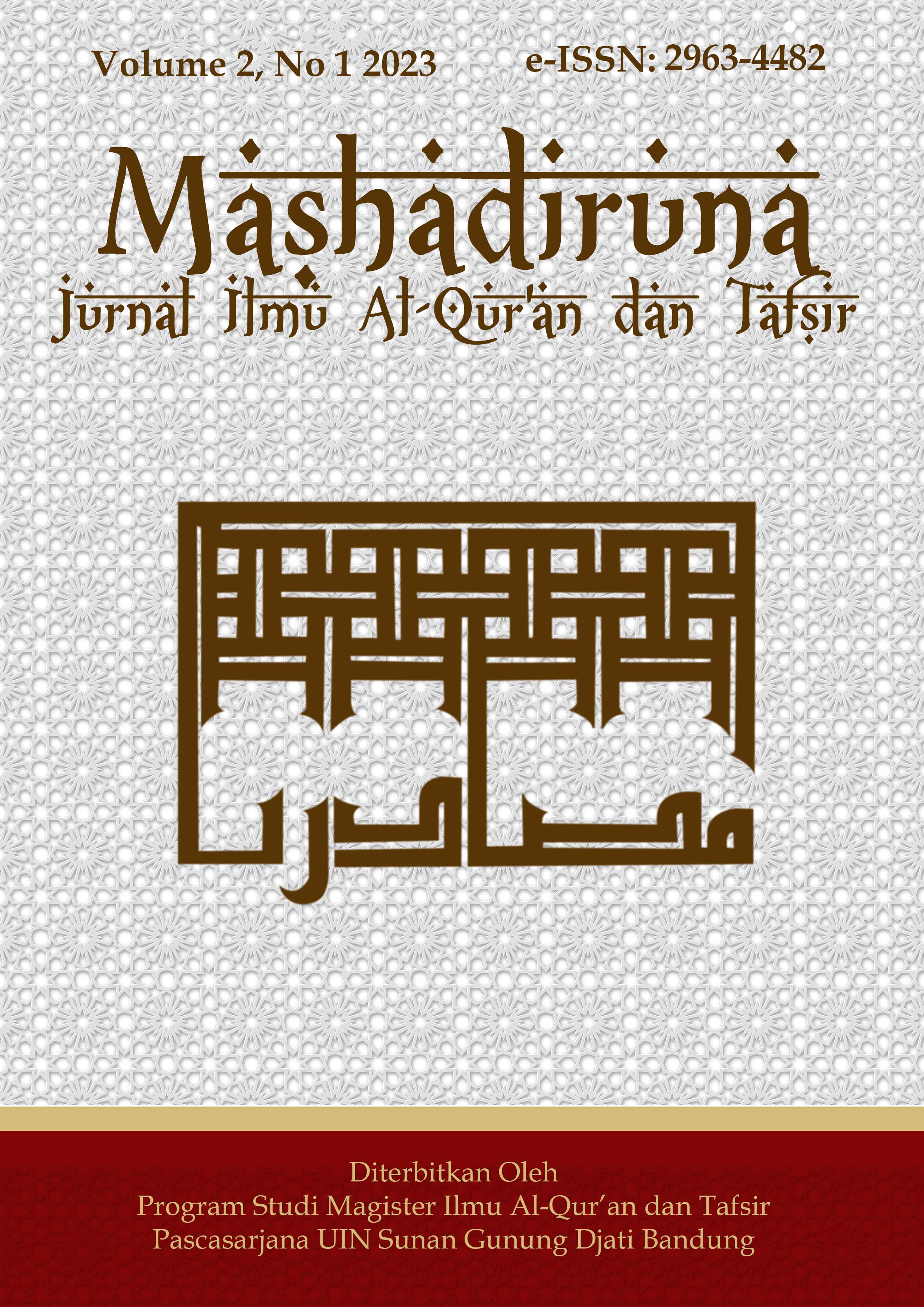Critical Analysis of Aisyah Abd Al-Rahman’s Interpretation of Al-Insan’s Pronunciation in Al-Tafsir Al-Bayani Li Al-Qur’an Al-Karim
DOI:
https://doi.org/10.15575/mjiat.v2i1.23666Keywords:
Al-Insan, Bint Al-Syathi, Method of Tafsir, Al-Tafsir Al-Bayani Li Al-Qur’an Al-Karim.Abstract
This article targets to respond critically to Bint Al-Syathi's interpretation of the term al-insan in his commentary ‘al-Tafsir al-Bayani li al-Qur'an al-Karim’. As a support for research, this article uses qualitative techniques through records collection the usage of library studies. The method uses an analytical descriptive technique if you want to provide an authentic description of the object. as well as using a historic technique to be extra comprehensive in photographing beyond events in a measurable manner. Bint Al-Syathi has an independent approach which he applies in his interpretation based totally on literary style. whilst he explains the that means of al-insan along side its context, the consequences of its meaning will now not be separated from the regulations of the Arabic language, even though he also makes use of historical considerations based on the guidelines of ‘sabab al-nuzul’. primarily based on those considerations, Bint al-Syathi constantly consistently interprets the pronunciation of al-insan because it's far interpreted as an ism of a kind which is judged based on its generality without exception. Bint al-Syathi's view is part of the consequence in strengthening his method of Tafsir, which of path additionally has some components that can not be prevented within the process of criticism.References
Al-Banna, G. (2005). Evolusi Tafsir. Qisthi Press.
Al-Baqi, M. F. A. (2007). Al-Mu’jam al-Mufahras li-Alfazh al-Qur’an al-Karim. Dar el-Hadith.
Al-Qaththan, M. (2000). Mabahits fi ’Ulum al-Qur’an (3rd ed.). Maktabah al-Ma’arif li al-Nasyr wa al-Tauzi’.
Al-Rahman, A. A. (n.d.). Al-Qur’an wa Qadhaya al-Insan. Dar el-Maarif.
Al-Rahman, A. A. (2017). Al-Tafsir Al-Bayani li Al-Qur’an Al-Karim Juz 1 (9th ed.). Dar el-Maarif.
Al-Rahman, A. A. (2020). Al-Tafsir Al-Bayani li Al-Qur’an Al-Karim Juz 2 (7th ed.). Dar el-Maarif.
Al-Sya’rawi, M. M. (1997). Tafsir al-Sya’rawi. In Misr: al-Maktabah al-Tawfiqiyyah, nd.
Alwi, M. dan I. P. (2019). Menyoal Konsistensi Metode Penafsiran Bint Syathi tentang Manusia (Studi Kitab Maqal fi al-Insan: Dirasah Qur’aniyyah). Al-Bayan: Studi Al-Qur’an Dan Tafsir, 4(2), 82–92.
Anggraeni, F. A. dan A. W. (2017). Semantik Konsep dan Contoh Analisis. Madani.
Anshari, F. A. (2021). Konsep Hablun Dalam Al-Qur’an (Suatu Kajian Dengan Pendekatan Semantik). UIN Sunan Gunung Djati Bandung.
Dewan Redaksi Ensiklopedi Islam. (2002). Manusia. In Ensiklopedi Islam (10th ed., p. 356). PT. Ichtiar Baru van Hoeve.
Et.All, D. D. (2020). Desain Analisis Semantik Alquran Model Ensiklopedik: Kritik atas Model Semantik Toshihiko Izutsu. Al-Quds: Jurnal Studi AAl-Qur’an Dan Hadis, 4(2), 181–206.
Izutsu, T. (2002a). Ethico-religious Concepts in the Qur’an (Vol. 1). McGill-Queen’s Press-MQUP.
Izutsu, T. (2002b). God and Man in The Qur’an (Edisi Baru). Islamic Book Trust.
Izutsu, T. (2003). Relasi Tuhan dan Manusia: Pendekatan Semantik Terhadap Alquran. Tiara Wacana Karya.
Izzan, A., & Tamimi, T. M. (2022). The Concept of Dhikr in the Quran and its Relation to Mental health (Analysis Study of Surah Ar-Ra’d Verse 28). Mashadiruna: Jurnal Ilmu Al-Qur’an Dan Tafsir, 1(1), 25–32.
Jansen, J. J. G. (1997). Diskursus Tafsir al-Qur’an Modern (1st ed.). Tiara Wacana Yogya.
Kouj, M. A. (n.d.). ’Aisyah Abd al-Rahman (Bint al-Syathi) wa Makanatuha fi Tafsir al-Qur’an (1913-1998) (p. 10).
Saddad, A. (2017). Konsep Dalal dalam Al-Qur’an (Kajian Semantik Al-Qur’an). IAIN Tulungagung.
Septiana, N. (2019). Pendekatan Aisyah Abdurrahman (Bint Syati’) dalam Al-Tafsir Al-Bayani. Pancawahana: Jurnal Studi Islam, 14(1), 68–77.
Setiawan, M. N. K. (2006). Al-Qur’an Kitab Sastra Terbesar. eLSAQ Press.
Sukardi. (2012). Metodologi Penelitian Pendidikan (11th ed.). Bumi Aksara.
Syam, I. K., Komarudin, E., & Taufiq, W. (2022). Types and Purposes of Kinayah in the Qur’an. Mashadiruna: Jurnal Ilmu Al-Qur’an Dan Tafsir, 1(1), 17–24.
Syamsuddin, S. (1998). An Examination of Bint al-Shati’s Method of Interpreting the Qur’an. McGill University.
Syarif, M. I. (2008). Ittijâhât al-Tajdîd fi Tafsîr al-Qur’ân al-Karîm (1st ed.). Dar al-Salam.
Thohari, F. (2009). Tafsir Berbasis Linguistik: Al-TafsÄ«r Al-BayÄni Li Al-Qur’Än Al-KarÄ«m Karya ‘Āisyah ‘AbdurrahmÄn Bintu SyÄti.’ Adabiyyat, 8(2), 233–244.
Ulya. (2017). Berbagai Pendekatan Dalam Studi Al-Qur’an (1st ed.). Idea Press.
Yayan, R., & Dadan, R. (2013). Metodologi Tafsir Al-Quran. Pustaka Setia.
Zulaiha, E. (2017). Tafsir Kontemporer: Metodologi, Paradigma dan Standar Validitasnya. Wawasan: Jurnal Ilmiah Agama Dan Sosial Budaya, 2(1), 81–94.
Downloads
Published
Issue
Section
License
Authors who publish with this journal agree to the following terms:
- Authors retain copyright and grant the journal right of first publication with the work simultaneously licensed under a Creative Commons Attribution License that allows others to share the work with an acknowledgment of the work's authorship and initial publication in this journal.
- Authors are able to enter into separate, additional contractual arrangements for the non-exclusive distribution of the journal's published version of the work (e.g., post it to an institutional repository or publish it in a book), with an acknowledgment of its initial publication in this journal.
- Authors are permitted and encouraged to post their work online (e.g., in institutional repositories or on their website) prior to and during the submission process, as it can lead to productive exchanges, as well as earlier and greater citation of published work (See The Effect of Open Access).
